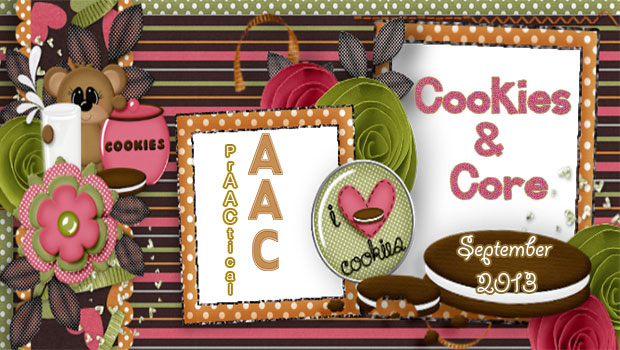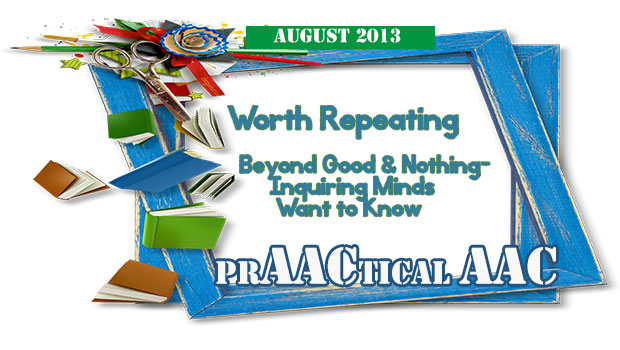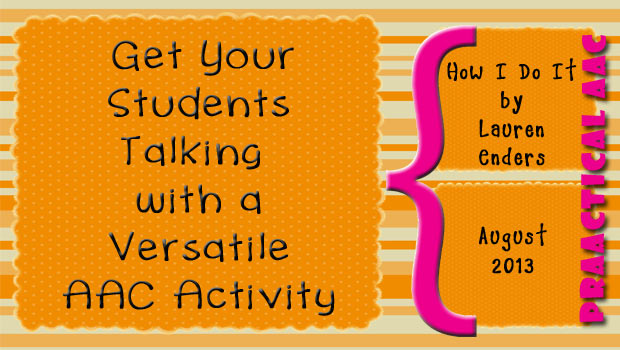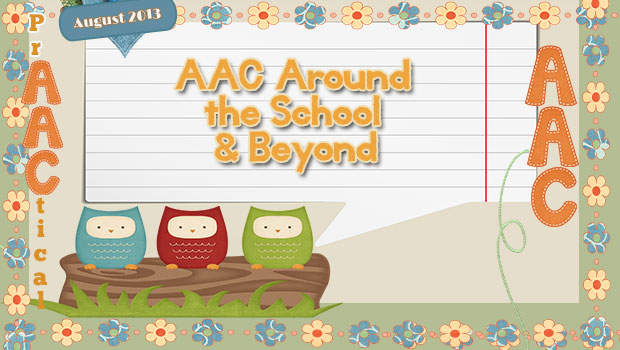350 Search Results for aided language input
September 13, 2013
by Carole Zangari -

It’s a new semester for us and we’re having lots of conversations with student clinicians about teaching strategies. Here are some of the things they’re putting in their AAC toolkits. Making language visible: Use visual supports to give information, explain, set boundaries, and make expectations clear. Aided language input and focused language stimulation: Teach AAC by speaking AAC. Communication temptations: Make the client want to communicate to get his/her own agenda met Expansions and extensions: The language facilitation strategies we all studied in our language intervention classes work in AAC, too! Repetition with variety: Working on the same thing in different ways is a sure way to build learning and keep treidthings fresh Contrastive examples: Teach through the power of clear examples, both positive AND negative Backward and forward chaining: Great for teaching things that have multiple steps, like sending emails or posting to Facebook Structure: Creating structure helps learner better... [Read More...]
September 12, 2013
by Robin Parker -

School has begun for almost everyone. Some classes have been in session for a while and routines have been formed, learning is taking place, behaviors have settled down. Now comes what can seem like the hard part: Keeping up with and expanding the strategies that helped students become successful. Instead of trying to fade AAC displays/devices and visual supports, stick with the basics and expand how they can be used. Because if you don’t use it, you may lose it. So: Keep up with: Visual Schedules– monthly, daily, and mini. Even if students know the schedule, continue to use it. Most of us would not like ‘losing’ our day planner or ‘to do’ lists even though we know our schedules. Aided Language Input First- Then Visual Support Visual Boundaries Access to a AAC Display/Device– And the display or device is with the student All the time, everywhere, charged, working, and... [Read More...]
September 5, 2013
by Robin Parker -

It is International Literacy Month. We always like to celebrate with food. So when we found these cookies at Ikea we just had to get them, use them, and of course eat them. Here is one of the activities we used with these delicious cookies. Can you guess the goals? To create a meaningful language experience, we started with the cookies in a closed brown bag (communication temptation) and “like it” spelled out on the table. Then we took the box of cookies out, spelled “like it”, waited expectantly and after prAACtice with spelling and saying in/out, more prAACtice and Aided Language Input, the student used the cookies to add “out” So the cookies were taken out. We had a yummy snack. Then it was time for recess but before cleaning up, the student does this: Apparently he wanted to go on the swing first. Note: Other visual supports/AAC... [Read More...]
September 4, 2013
by Robin Parker -

Strategy of the Month Back to School with AAC AAC ‘Must Haves’ for the Classroom & Speech Room PrAACtical Partnerships: AAC & Academics AAC Around the School and Beyond Core Words & the Curriculum PrAACtical Thinking 5 Things to Remember About AAC Technology Fun Friday Commenting to the Max 31 Posts You May Have Missed in July Keep Calm & …………. Great Music Apps & AAC Language Goals 5 Free Resources for Making Communication Boards & Visual Supports 5 Reasons to Say Yes to ‘NO’ Magic Moments with Tellagami Watch It Wednesday: AAC Core Word Vocabulary teaching by Gail Tatenhove & Robin 5 Ways to Use Sequenced Message SGDS and APPS 7 Writing Apps & Activities for ALL Writers PrAACtical Uses of QR Codes Watch This: Example of Teaching Expressive Language with the iPad & AAC Device by the Awesome AAC Chicks 5 Things to Consider About Data Collection in... [Read More...]
August 31, 2013
by Robin Parker -

Core words can easily be incorporated into academic curriculum. There just needs to be systematic planning for core word vocabulary and then of course the joining of fringe words. One of the best visual explanations of core words is in the now ‘famous’ you tube video Language Stealers (HD). If you have not seen it, it is worth watching for many reasons but in the context of this post, it perfectly illustrates how you can teach about Greek and Roman history with core words. Planning for Core Words for the Classroom (& ALL School Activities) Have the core word communication board with you at ALL times– If you (SLP/Educator) have your core word communication board, you can model and teach the target core words during all lessons. A premise of this approach is that the student has access to their core word vocabulary display on a no-tech communication board or on their... [Read More...]
August 30, 2013
by Robin Parker -

by Carole Zangari, originally published on August 27, 2012 “How was school?” (Good) “What did you do?” (Nothing) This scenario plays out in many cars and kitchens in the after school hours and it can be hard to know who is more frustrated: the kids for being asked or the parents for not getting satisfactory answers. And still, we repeat the process day after day. Of course, we want to know the fine details of what happened and how our children felt, but in some cases, we’d settle for ANY school-related conversation at all. I’ll be the first to admit that it took me way too long to get the hang of how to get information about my children’s school days, and it seemed like just when I did, pow! They were pre-teens and then teenagers. New rule book. Here are some ‘lessons learned’ along the way about those afterschool conversations and... [Read More...]
August 29, 2013
by Carole Zangari -

We are so excited to start off the new school year with a wonderfully prAACtical post by Lauren Enders. Lauren’s “How I Do It” posts have been very popular and this one is no different. Today, she shares ways to incorporate key AAC principles in engaging intervention activities and models that with high school students. :::::::::::::::::::::::::::::::::::::::::::::::::::::::::::::::::::::::::::::::::::::::::::::::::::::::::::::::::::::::::::::::::: LEARNING TARGETS (Samples: can be changed to meet student goals) Using core vocabulary, the student will: control the actions of others (beginning with core words like “more”, “stop”, “go”, “again”, and “different”) express his or her opinions through commenting (beginning with core words such as “like”, “don’t like”, “good”, “bad”, and “silly”) TARGET POPULATION: all ages (I have used variations of this activity successfully with students from age 3 through age 21.) TYPE OF AAC: ALL types!! What’s crucial here is the availability of core vocabulary, not the system used. Systems used can vary from... [Read More...]
August 24, 2013
by Robin Parker -

For the August Strategy of the Month, we have been thinking, writing, & talking about AAC in School. School is where AAC learners spend a large portion of their days. There needs to be multiple opportunities for students to USE and LEARN AAC each day. More than that though, we strive for full participation and interaction for students who use AAC. Students should not have to prove that they can do these things before they have ACCESS to AAC strategies and intervention. Here are some things that can be done to help build AAC participation for both students and educators. Provide ACCESS to AAC devices and visual supports throughout ALL activities in ALL places in school and on school sponsored trips/community based instruction. Provide Aided Language Input when teaching AAC to students. Use a Core Word approach when teaching AAC to students but don’t forget about Fringe Vocabulary. Learn and use partner assisted communication... [Read More...]
August 19, 2013
by Carole Zangari -

In some of our posts, we talked about using QR (Quick Response) codes as a way to share information. If you are new to QR codes, they are like bar codes in that you scan them with some kind of device (like a smart phone or tablet) that has software or an app that reads the code. Then what? Then it takes you to whatever the author wanted you to see or hear. For example, a QR code on an SGD in a loan library might take you to a quick start tutorial on the manufacturer’s website. A QR code on a handout might take you an electronic copy of that handout that is stored on someone’s website or a cloud service, like DropBox or Google Docs/Drive. A QR code on the student’s picture card ring might take you to an audio recording of directions for how to complete a... [Read More...]
August 10, 2013
by Robin Parker -

As we were getting ready for back to school and thinking about ‘must haves’, it quickly became apparent that it is not so easy to narrow it down. And the ‘must haves’ would definitely vary depending upon type of class, students, and even school. Based on a wide variety of differences, we organized a wide variety of choices to explore (we apologize in advance if we got carried away but…). Choose what you need, bookmark what you may need later and let us know your ‘must haves’ for a classroom and speech room AAC collaborative approach. We will create an ongoing list. Get Started Before School Starts Do these 10 Things to Get Started with AAC if you are new to an AAC student or classroom Provide AAC Support in the Classroom. Support teachers and educators with tips from Jane Farrall, & learn about AAC in the Classroom by Joan... [Read More...]









